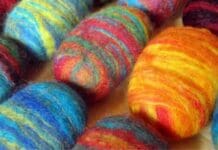PLUS: Olive Oil Removes Scuff Marks from Leather
The team at Dobell – the smart man’s choice for smart and formal wear – collaborated with two cleaning experts – Sarah Dempsey from MyJobQuote and Henry Paterson from Housekeep – to discuss what to do if you accidently spill on and stain your partywear this festive season.
Firstly, Henry mentioned that you should “always check the care labels on your products before deciding how they should be washed. It’s well worth familiarising yourself with the care labelling system, so you can understand what labels mean at a glance”.
The advice, for 9 specific stains, includes:
Red/mulled wine – Sarah says that “red wine and mulled wine spills are much easier to deal with while they’re still wet, so you need to tackle them quickly. If you’re not at home, absorb as much as you can with a paper napkin and use white wine or soda water to keep the stain moist until you get home. As long as the spill is still wet, you can sprinkle salt over the area to absorb the wine. As this is a mild treatment, it should be safe to use on any fabric. Brush off the salt and soak with cold water or soda water and blot out the remaining stain with an absorbent towel. Apply a pre-wash stain remover if the mark’s still visible and put your garment on a cold wash to avoid setting the stain”.
White wine/prosecco – Sarah advises that “as with red wine, white wine and prosecco spills should be tackled quickly before they dry as this makes them easier to remove from all types of material. Rinsing with soda water and blotting with an absorbent towel should take out the worst before you wash it in the machine. This avoids the need for harsh stain removers”. Henry added that “rinsing the stain with cold water might be enough to get a white wine stain out. Do this from behind the stain on the inside of the garment. Once the stain is flushed out, you can pop the item in the laundry as normal. If rinsing doesn’t do the trick, apply some laundry stain remover directly onto the stain to pre-treat it before you pop it to the laundry as normal”.
Beer – Grant Durrell, Senior Menswear Designer at Dobell, shared that the trick for beer stain removal is to apply some liquid soap, whether it’s dish soap or laundry, it doesn’t matter, but you need to mix it with some lukewarm water. Grab a clean towel or a sponge and dab at the stain until it’s gone. If for some reason you didn’t get to the stain while it was fresh, you can mix some baking soda and liquid detergent together, use an old clean toothbrush, and rub it into the stain. Let it sit for 5 to 10 minutes. Rinse with some lukewarm water. The baking soda will act as an odour absorber and will grab any remnants of that pesky beer odour. A variation of this method is to just let the cleaning mixture sit on the stain and then after 5 or 10 minutes, toss it into the washing machine and wash normally. For fresh beer spills on clothes, Sarah advises to “blot with a paper towel and put on a cold wash before it dries”.
Gravy – Gravy contains oil, so Grant says to quickly wipe excess gravy that’s spilled onto your clothing to stop it soaking in. Pre-treat with a prewash stain remover, and then launder, using the hottest water safe for the fabric. Sarah suggested to “use a biological detergent as this has enzymes that can tackle the gravy stain. For materials such as wool that can’t go on a hot wash, remove the excess gravy, then gently rub with chalk or sprinkle with baking soda to absorb oily residues. If the stain persists, dab with white spirit before soaking your items in a suitable detergent”.
Oil (from food) – Grant recommends that the best and most effective way to remove any type of stain is to take your garment to a dry cleaner. This will give you peace of mind that your garment is being professionally cleaned. However, if you want to try removing the stain at home, follow these 6 steps – first, blot with a towel. Then set your stained garment on a flat surface and sprinkle a small teaspoon size of baking soda over the stain. Let the baking soda sit on the stain for 30 minutes. Scrub the baking soda off the garment using a toothbrush. If the baking soda starts to clump up that means it is properly absorbing the oil. Don’t worry if some baking soda residue remains, it will wash out in the next step. Pour dish soap over the baking soda, just enough to cover the stain. Massage the dish soap into the baking soda. You can also use your cleaning toothbrush here for more scrubbing power on sturdier fabrics. Give your soapy garment a thorough rinse under running water before throwing it into the washing machine. You should always avoid putting a garment that has any amount of dish soap in the fabric into the washing machine—excess soap suds are a known way to ruin a washing machine! Wash the garment in the washing machine using your preferred detergent, following the instructions on the garment care label. Air dry (heat from a dryer will set that oil stain and make it harder to remove).
Glitter – Henry advises to “dab the glitter with a clean, slightly damp microfibre cloth and you should be able to lift most of it off”. Sarah added that “it’s best to get rid of glitter from your partywear before you wash it to prevent these small particles ending up in our water courses. So, use a lint roller or vacuum to remove bits of glitter stuck in clothing fibres. For more delicate materials, you may prefer to use a damp microfibre cloth to wipe the glitter off”.
Mud – Unlike most clothing stains, Sarah says that “it’s better to let mud dry, so it will flake off. You can scrape excess mud from clothes with a spoon and then rub with a paste made from detergent and water as a pre-wash treatment. For items with loose fibres such as woolly jumpers, you’ll need to work gently to avoid pulls and then dab with white spirit instead of using a paste”.
Sweat – For sweat stains on clothes, Sarah noted to “add a cup of white vinegar or lemon juice to warm water and leave the items to soak. For yellow stains that persist on whites such as cotton blouses and shirts, add oxygen bleach to your normal wash”.
Dust – Sarah shared that “it’s best not to wipe dusty clothing as it will push the dirt particles into the fibres. So, take dusty clothes outside and give them a good shake. You can follow this will a lint roller or some sticky tape to remove the remaining particles from smooth and tightly woven fabrics such as cotton and canvas. Or use a hand vacuum on a low setting for materials such as velvet and tweed”.
Grant Durrell, Senior Menswear Designer at Dobell, commented:
“After two covid years of pent-up frustration of limited Christmas parties people want to celebrate in style. Even with the cost-of-living crisis people need a release from the day-to-day pressures, and there is no better way than to let your hair down with a Christmas party. However, accidents – such as spills and stains – can happen amid the merriment, so we hope you find this advice of use.
“A final hack… the best way to remove scuff marks on any leather surface is by using olive oil, a common household item. First, use a brush with soft bristles to brush off any dirt or debris, then dip a microfiber cloth into a small amount of olive oil and gently rub it over the scuff marks. It should sit for about 15-20 minutes, and you can simply use a clean cloth to wipe it right off.
“Also, when it comes to storing your partywear after the festive season is over, cotton shirts are best stored hung on a hanger in a wardrobe at room temperature. Avoid damp wardrobes or excessive heat. Conversely, polyester items can be stored anywhere as long as they are dry. For velvet items, hang velvet jackets on a hanger. Velvet has a short pile and easily crushed, so if it’s not correctly stored the next time you come to use it will look extremely wrinkled. As wool is a natural fabric these are best stored hanged in a clean, room temperature wardrobe”.
For more information, visit: https://www.dobell.co.uk/blog/christmas-partywear-2022-styling-advice-and-garment-care-guide

| [donate]
| Help keep news FREE for our readersSupporting your local community newspaper/online news outlet is crucial now more than ever. If you believe in independent journalism,then consider making a valuable contribution by making a one-time or monthly donation. We operate in rural areas where providing unbiased news can be challenging. |



















